SHAH ALAM: ON Friday, Singapore Defence Minister launched Independence, the RSN’s first Littoral Mission Vessel (LMV). Seven more LMVs will be built to replace the Fearless-class patrol vessels (PVs), which have been in service for 20 years.
Among the key features of the LMV according to a release is the Integrated Command Centre where the ships Bridge, Combat Information Centre and Machinery Control Room are co-located.
Normally they are placed in the different areas of the ship, one reason for which is to allow the ship to function even after suffering battle damage. However for a small ship like LMV putting all the main control functions in one area would allow better cordination and moreover free up space below decks for other functions.
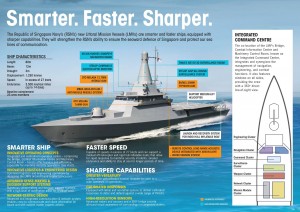
According to the release, the LMVs also have greater endurance than the Fearless-class vessels and are able to stay at sea for up to 14 days (3,500 nautical miles). The LMVs ability to respond rapidly to maritime security incidents is further enhanced with its faster speed in excess of 27 knots and the ability to support a medium-lift helicopter.
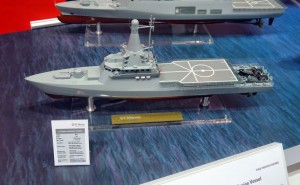
The vessels will be fitted with 12 VL MICA surface to air missiles. There is no mention of the SSMs. Perhaps this capability is a Fitted For but Not Equipped With for the first vessel.
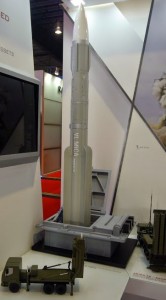
Based on the specifications published, it appears that the LMV has some of the equipment fitted on RMN’s own LCS. Apart from the VL MICA, both shared the same main radar, the Thales 3D radar and both are probably housed in the same stealthy mounting.
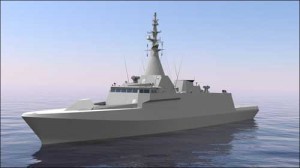
Of course, RMN’s LCS is much bigger, some 2500 tonnes compared to the much smaller LMV. The LMV is actually slightly bigger than the missile corvettes proposed by Daewoo of South Korea.
However, unlike that project, funds for the LMV has been allocated and probably by the time we decide to recapitalise the RMN patrol fleet, RSN will have another batch of vessels already to go.
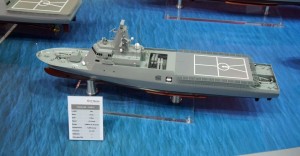
So what is the cost of an LMV? There is no official announcement but ST Marine – the builder of the LMV – secured a US$880 million to build four 75 metres PVs for the Royal Oman Navy in 2012. Based on that contract we can assume that the LMV will cost at least US$200 million (RM833 million) each.
Friday, February 14, 2014
Fresh details of the Republic of Singapore Navy's (RSN) Littoral Mission Vessel surface
A model of the Littoral Mission Vessel (LMV) displayed at ST Marine's stand at the Singapore Airshow 2014 points to the design evolution that this upcoming Republic of Singapore Navy (RSN) warship class has undergone since the concept was shown to the public in May last year.
While details are still sparse, the updated model provides telling indications of what we can expect the LMV design to look like when the first of class hits the water.
The hypotheses floated here assume the features on the scale model displayed at SA 2014 are a passable resemblance to the finished product.
Spot the differences: The Littoral Mission Vessel (LMV) scale model displayed in February 2014 (above) shows subtle yet noteworthy differences to the first LMV model unveiled to the public in May 2013 (below) at the Republic of Singapore Navy Navy Open House.
Prominent among the changes to her hull form is the addition of hull strengthening strakes either side of the bow. These strakes, which are common on salvage vessels and the ST Marine-built Submarine Support Rescue Vessel, MV Swift Rescue, are unique to this RSN warship class. The strengthened forr'ard hull might contribute to the LMV's robustness during incidents at sea which may involve ramming.
The new model also displays what appears to be air intakes/outlets under the flight deck for the air-breathing engines (of unknown type) and intakes for ship air handling units and machinery.
Topside, subtle yet noteworthy changes have been made to her superstructure and equipment fit.
These include:
* A prominent step of unknown purpose forr'ard of her bridge superstructure
* A pedestal for a fire control radar dish and what appears to be an electro-optic ball on the bridge roof. Placed in that position, both sensors should command a 180-degree coverage, which would be sufficient for the firing arc of the 76mm OTO Breda A-gun.
* As we move aft of the bridge wing, we note a flat faced array which appears to be a long-range acoustic device. These were used with notable success during RSN counter-piracy sweeps in the Gulf of Aden.
* The sensor mast is completed by a pole mast, possibly for hoisting signal halyards and navigation lights.
* The sensor mast has a different side elevation from the May 2013 incarnation.
Still missing are outlets for her air-breathing engines. These are expected to take the form of drowned exhausts and their location on her hull would be closely followed as these contribute to her wake profile and noise signature. It remains to be seen if bleed air from her engine exhaust would be used to coat her underwater hull with a layer of bubbles, which act as a masking device of sorts to reduce her acoustic signature.
When completed, each LMV should measure 80 metres bow to stern, 12 metres wide and have a displacement of around 1,150 tons. Max speed has been quoted as >27 knots. She would embark a core crew of 30 personnel and a mission crew of 30 pax.
As the LMV design evolution gathers pace, Singapore watchers should avoid placing too much scrutiny on drawings and models displayed by ST Marine and the RSN. Such open source material are known to have fallen far short of what the actual product looks like when the real thing is unveiled.
The Missile Corvettes (MCVs) designed for the RSN under Project S are a classic example. One of the first drawings of the warship, published by Pioneer magazine in April 1988, excluded key anti-submarine warfare armament and sensors such as the torpedoes and VDS, along with all electronic warfare lumps and bumps eventually added to the MCVs under Project H, Project J, Project S and Project W.

 The LMV's launch-and-recovery system, located at the stern, can accommodate up to two RHIBs or the Protector unmanned surface vessel (USV). (IHS/Ridzwan Rahmat)
The LMV's launch-and-recovery system, located at the stern, can accommodate up to two RHIBs or the Protector unmanned surface vessel (USV). (IHS/Ridzwan Rahmat)
 An artist's impression of the LMV in its final configuration. (Singapore Ministry of Defence)
An artist's impression of the LMV in its final configuration. (Singapore Ministry of Defence)
While details are still sparse, the updated model provides telling indications of what we can expect the LMV design to look like when the first of class hits the water.
The hypotheses floated here assume the features on the scale model displayed at SA 2014 are a passable resemblance to the finished product.
Spot the differences: The Littoral Mission Vessel (LMV) scale model displayed in February 2014 (above) shows subtle yet noteworthy differences to the first LMV model unveiled to the public in May 2013 (below) at the Republic of Singapore Navy Navy Open House.
Prominent among the changes to her hull form is the addition of hull strengthening strakes either side of the bow. These strakes, which are common on salvage vessels and the ST Marine-built Submarine Support Rescue Vessel, MV Swift Rescue, are unique to this RSN warship class. The strengthened forr'ard hull might contribute to the LMV's robustness during incidents at sea which may involve ramming.
The new model also displays what appears to be air intakes/outlets under the flight deck for the air-breathing engines (of unknown type) and intakes for ship air handling units and machinery.
Topside, subtle yet noteworthy changes have been made to her superstructure and equipment fit.
These include:
* A prominent step of unknown purpose forr'ard of her bridge superstructure
* A pedestal for a fire control radar dish and what appears to be an electro-optic ball on the bridge roof. Placed in that position, both sensors should command a 180-degree coverage, which would be sufficient for the firing arc of the 76mm OTO Breda A-gun.
* As we move aft of the bridge wing, we note a flat faced array which appears to be a long-range acoustic device. These were used with notable success during RSN counter-piracy sweeps in the Gulf of Aden.
* The sensor mast is completed by a pole mast, possibly for hoisting signal halyards and navigation lights.
* The sensor mast has a different side elevation from the May 2013 incarnation.
Still missing are outlets for her air-breathing engines. These are expected to take the form of drowned exhausts and their location on her hull would be closely followed as these contribute to her wake profile and noise signature. It remains to be seen if bleed air from her engine exhaust would be used to coat her underwater hull with a layer of bubbles, which act as a masking device of sorts to reduce her acoustic signature.
When completed, each LMV should measure 80 metres bow to stern, 12 metres wide and have a displacement of around 1,150 tons. Max speed has been quoted as >27 knots. She would embark a core crew of 30 personnel and a mission crew of 30 pax.
As the LMV design evolution gathers pace, Singapore watchers should avoid placing too much scrutiny on drawings and models displayed by ST Marine and the RSN. Such open source material are known to have fallen far short of what the actual product looks like when the real thing is unveiled.
The Missile Corvettes (MCVs) designed for the RSN under Project S are a classic example. One of the first drawings of the warship, published by Pioneer magazine in April 1988, excluded key anti-submarine warfare armament and sensors such as the torpedoes and VDS, along with all electronic warfare lumps and bumps eventually added to the MCVs under Project H, Project J, Project S and Project W.
Singapore launches first Independence - class Littoral Mission Vessel
02 July 2015

Key Points
- Singapore launches LMV Independence, the first replacement for Fearless-class patrol vessels
- The ship will prove out new concepts for the RSN, including an integrated bridge and combat centre
Singapore has launched the first of eight Littoral Mission Vessels (LMVs) on order for the Republic of Singapore Navy (RSN).
The vessel, Independence , was launched on 3 July at ST Marine's shipyard in Benoi in a ceremony presided over by Singapore's defence minister Ng Eng Hen.
Singapore's Ministry of Defence (MINDEF) signed a contract for the LMVs in January 2013, with the ships replacing the RSN's 11 Fearless-class patrol boats (which have been in service since the mid-1990s). The LMV has been jointly designed by Saab Kockums AB and ST Marine, and is being built in Singapore by ST Marine. Singapore's Defence Science and Technology Agency (DSTA) is the overall manager and systems integrator for the programme.
The Independence class is fitted with one Oto Melara 76 mm main gun, two Oto Melara Hitrole 12.7 mm remote-controlled weapon stations (one each on the port and starboard sides), and a stern-facing Rafael 25 mm Typhoon gun system. Protection against hostile aircraft and missiles is provided by MBDA's VL Mica anti-air missile system deployed via a 12-cell vertical launching system (VLS) in the forward section.
The platform's non-lethal options are provided by two water cannon and two remote-controlled long-range acoustic device (LRAD) system turrets with integrated xenon lights.
The sensor suite includes the Thales NS100 3D surveillance radar, Kelvin Hughes' SharpEye navigation radar, and an electro-optical director and 360° surveillance system supplied by Stelop (a business unit of ST Electronics). In response to a question from IHS Jane's , the RSN confirmed that the LMV does not have an anti-submarine warfare (ASW) capability.
The 1,250-tonne ship has a length of 80 m, a beam of 12 m, and a draught of 3 m. It has a top speed in excess of 27 kt and a range of 3,500 n miles on an endurance of 14 days.
 The LMV's launch-and-recovery system, located at the stern, can accommodate up to two RHIBs or the Protector unmanned surface vessel (USV). (IHS/Ridzwan Rahmat)
The LMV's launch-and-recovery system, located at the stern, can accommodate up to two RHIBs or the Protector unmanned surface vessel (USV). (IHS/Ridzwan Rahmat)
The LMV can embark a medium-lift helicopter on its flight deck. It also features a launch-and-recovery system (provided by Norwegian Deck Machinery) that can accommodate at the stern two rigid hull inflatable boats (RHIBs) or the Protector unmanned surface vessel (USV). The LMV has a baseline crew complement of 23, including five officers.
A concept that is being proven out in the RSN for the first time is the LMV's integrated command centre, which co-locates the ship's bridge, combat information centre (CIC), and machinery control spaces.
"The integrated command centre integrates and synergises the management of navigation, engineering, and combat functions to achieve greater operational effectiveness and efficiency, especially during maritime security operations", said MINDEF. This approach mirrors that adopted on the US Navy's Independence-class Littoral Combat Ship (LCS).
Also fitted is a remote monitoring system that allows for real-time reporting of serviceability data. "The ship's platform and combat systems' health status can also be transmitted back to shore for centralised monitoring and prognosis of the systems to detect anomalies and plan for pre-emptive maintenance," said MINDEF.
To maximise versatility, the LMV has been configured to deploy a range of containerised mission packages such as a medical module to support humanitarian assistance and disaster relief (HADR) operations. The platform can also deploy unmanned systems for surveillance and mine countermeasures (MCM) operations.
Following the launch, Independence will undergo a combat system installation period, and will then start sea trials. The vessel is scheduled for delivery in 2016 and is expected to be fully operational by 2017. All eight LMVs are expected to achieve full operational capability by 2020.
COMMENT
Concepts such as the integrated command centre exemplify the RSN's service-wide effort to reduce manpower requirements. In an interview in the Singapore Armed Forces' publication Pioneer in May 2015, chief of navy Rear Admiral Lai Chung Han highlighted the republic's dwindling birth-rate as a challenge facing the service.
Other recent efforts to ease the manpower burden include the deployment on board RSN vessels of unmanned systems, such as the Scan Eagle unmanned aerial vehicle (UAV) and the REMUS autonomous underwater vehicle (AUV).
The LMV's lack of organic ASW capability, in contrast to its sonar-equipped predecessors, suggests that the RSN is now relying on its Formidable-class frigates as the service's main submarine prosecutors. It could also be an indication that the RSN may employ helicopter-based submarine prosecution capabilities for the LMVs.
 An artist's impression of the LMV in its final configuration. (Singapore Ministry of Defence)
An artist's impression of the LMV in its final configuration. (Singapore Ministry of Defence)



No comments:
Post a Comment